Boeing has been rocking creating their own videos and sharing them with the public on the 747-8 Intercontinental. Yesterday the 747-8I successfully completed high speed taxi tests at Paine Field. During the tests, the 747-8I reached a speed of 90 knots and lifted its front gear off the ground. She could have lifted off, but that will be saved until tomorrow.
Here are some other great 747-8I videos from Boeing:
* 747-8I’s dress rehearsal (03.16.11)
* Pilots of the 747-8I put it through the gauntlet (03.14.11)
* Start your engines! 747-8 starts engines its for the first time (03.09.11)
* The Intercontinental gets closer to first flight (03.04.11)
* The unveiling of the first 747-8I (02.13.11)
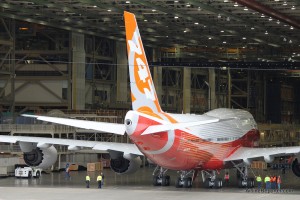
The first Boeing 747-8 Intercontinental coming out of the Boeing hangar.
Are you ready? The first Boeing 747-8 Intercontinental is scheduled to fly tomorrow, Sunday March 20th at 10am PST.
Yesterday the 747-8I completed its high-speed taxi tests and according to Boeing, it “performed well” and they are confident the aircraft is ready for first flight on Sunday.
The 747-8I is scheduled to take off at 10am PST from Paine Field (KPAE). It will then have a five hour flight before landing at Boeing Field (KBFI) at about 3pm PST. Again, all these times are subject to change due to weather and delays.
If you are in the local area, I hope you can make it out to see this orange beauty either take off or land. If you are unable to, you have quite a few options for watching the events:
* Follow @AirlineReporter, @FlightBlogger, @BoeingAirplanes, @PIBoeing on Twitter (omg what is Twitter?)
* Follow #7478FF hashtag on Twitter
* Boeing will have a live feed of the take off starting at 9:45am PST
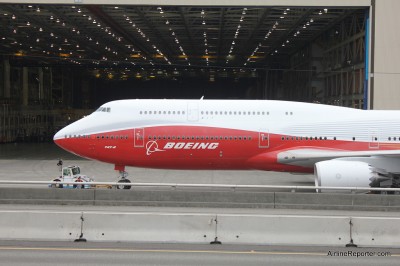
The first Boeing 747-8I being towed out of the Boeing Factory in Everett, WA
Get your camera (and umbrellas) ready. Boeing has announced that the first 747-8 Intercontinental is scheduled to fly on Sunday March 20th.
We hope this means it will take off on the 20th, but there are a number of different things that might get in the way to delay the first flight. I will be sure to keep you all updated.
Boeing stated in a press release today, “First flight of the 747-8 Intercontinental will occur after final flight readiness reviews, receipt of documentation from the U.S. Federal Aviation Administration and taxi testing. Both taxi testing and first flight are subject to weather conditions.”
Boeing did confirm that they will be providing a live feed of the first flight and of course you can expect people like Flight Blogger and myself providing lots of tweets.
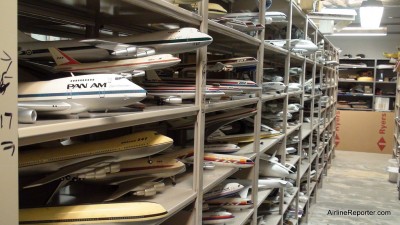
How would you like to have this airline model collection located in the Boeing Archive? Um, yes please.
A while back I had the amazing experience of checking out Boeing’s archive located in Bellevue, WA. My first post in September gave the general overall look at the archives. Unfortunately since then, I got distracted with other things and caused a delay. This post will be going over the models (airplane not people) found in the archives and next week I will be posting my interview with Boeing Historian Michael Lombardi.
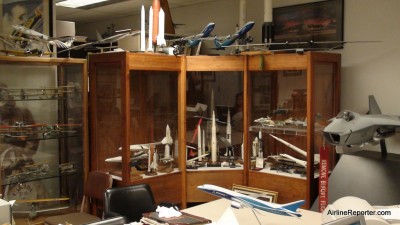
These are just some of the models located in the lobby of the Boeing Archive. They keep the real good ones locked up.
When I went for my visit in September, I was expecting the archives to be a bunch of boxes on shelves. One of the best surprises were all the amazing and unique models housed in the archives. From single aisle Boeing 747 mock ups to Boeing boats, I felt like a kid in a candy store needing a sugar rush. The archive has so many models, it has been difficult to store them all. I told Lombardi that I would be more than happy to store some at my house, but I don’t think that will work out. Although some models were spread around in the lobby and on random shelves, most were stored in two long rows of shelving. There were military and commercial airline models, but of course my main interest were the airliners.
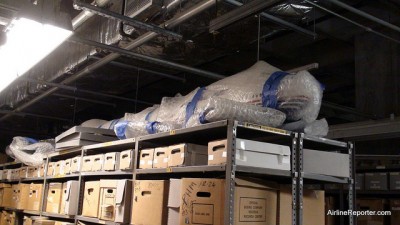
I got so distracted by learning about the Boeing boats, I forgot to take a photos. But I did catch this HUGE Boeing 747 model.
Did you catch I said “Boeing boats” earlier? I am not talking about the Boeing 314 Flying Clipper, I am talking about real boats. Using their knowledge from aerodynamics, Boeing dove into the world of hydrofoil/jetfoil boats. They first launched in 1962 and built boats for military and commercial use until 1988 when Boeing Marine Systems closed and sold the license for the Commercial Jetfoils to Kawasaki Heavy Ind. Lombardi tells me that some Boeing Jetfoils are still “flying” to Macao and between Korea/Japan.
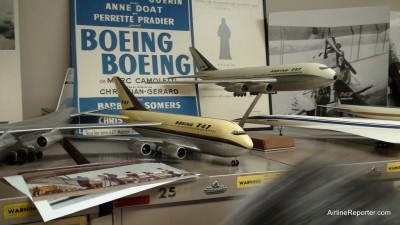
Two single aisle, double deck mock ups for the original Boeing 747.
When Boeing was looking at making a larger aircraft after the Boeing 707, they played with the idea of a double-decker, singled-aisle airplane like these two models depicted above. Can you spot the differences (larger version)? One has the wings in the middle of the fuselage, the other a bit higher. Also check out the differences in landing gears. These models look much more like the Airbus A380 than they do the Boeing 747. You can really see the nose of the Boeing 707/727/737 in the white model. Also, do not miss the Boeing SST model, there were quite a few of those spread out around the archive.
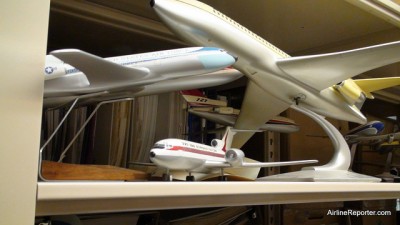
This is one odd-looking potential Boeing 727
This little guy (seen above) was hard to spot amongst all the models, but looked very interesting. Lombardi explained what the function of the engines being placed on the wings. “During the 1970s Boeing studied all aspects of commercial aviation and also reviewed the entire commercial family to see what could be improved. This model of the 727 shows one of those considerations it is a STOL 727 using a concept called USB or upper surface blowing. USB was successfully tested on the Boeing QSRA and the Boeing YC-14.” The Boeing 727 is one of my favorite airliners since it looks so majestic. I don’t think I would have the same love if it looked like the model above or like this other funky looking 727 model.
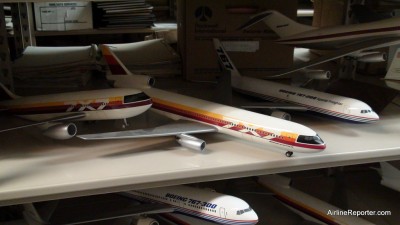
These show what Boeing was looking at with the Boeing 767.
There was a pretty big section of Boeing 767 prototype models in the Boeing archive. There were ones that closely resemble what became the Boeing 767 and others that looked… well, unique. Boeing was playing with the idea of making the 767 being a quad or even tri-jet aircraft. Probably the most interesting Boeing 767 prototype is the one you can see on the right on the photo above and detailed in the photo below.
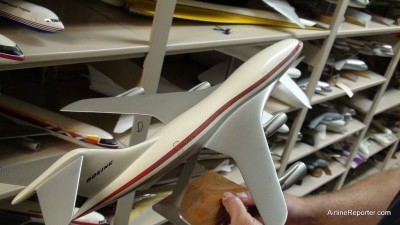
Check out the sweet waistline on this possible Boeing 767 design.
This was one of my favorite models. That slick waist-line shape would have allowed the plane to travel at near sonic speeds. Lombardi explained why it wasn’t chosen. “Much like the Sonic Cruiser and it did not go forward for the same reasons that the Sonic Cruiser did not go forward – the fuel burn increases dramatically at near sonic/transonic speeds because of the increased drag.” I would imagine the seat layout on the interior would have been interesting and a bit cumbersome.
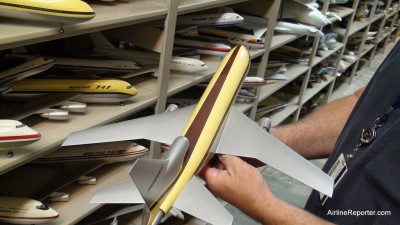
A model of the Boeing 747 Tri-Jet at the archive.
No matter how many times I have seen the mock ups, the Boeing 747 TriJet always looks odd to me. During the 1970’²s Boeing wanted to better compete with the DC-10 and L1011. The Boeing 747SP was too costly to directly compete, so for a short while, Boeing looked at creating a 747 with three jets instead of the standard four. The design has two jets on the wing and one on the tail in an ’œS’ configuration, much like the L1011. The concept was scrapped since it would take too much time, money, and a new wing design.
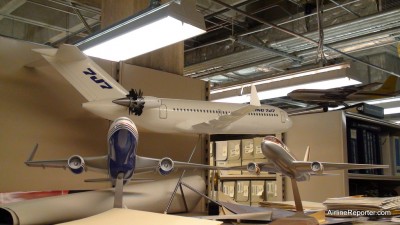
Ah, the Boeing 7J7. Wait a second... is that a Boeing 767 with foldable wings?
The Boeing archive wouldn’t be complete without a model of the Boeing 7J7. This aircraft was designed in the 1980’s with the idea of replacing the Boeing 727. It used Unducted Fan Engines on the rear of the plane that provided superior fuel economy. Boeing hoped the 7J7 would burn about half the fuel of the Airbus A320 and hoped to revolutionize commercial air travel. A reduction in oil prices and noise concerns ended up killing off the 7J7. Might we see another version of the UFE in the future? I am going to bet on yes.
Be sure to take a look at all 44 photos taken of the Boeing archive.
Inside The Boeing Company Archives
PART 1 | PART 2 | PART 3a | PART 3b | ALL PHOTOS | ALL STORIES
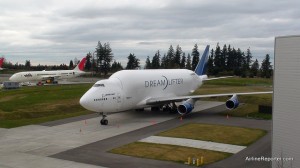
Head to the Future of Flight to get a close look of a Dreamlifter (N249BA) and four Boeing 787 Dreamliners.
Yesterday was a very nice day in Seattle for it being almost the middle of November. Figured it might be a good day to head back to Paine Field (KPAE) and take a look at what is going on. As always, there were a few nice surprises.
The biggest is one of the Dreamlifters (N249BA) is parked just feet away from the Future of Flight (photo). The DreamLifter is sitting right next to four Boeing 787 Dreamliners. Rumors are the Dreamlifter will be parked there until the end of the month and the Dreamliners should be there at least through the winter.
The 787’s and now the Dreamlifter are hanging out next to the Future of Flight due to Boeing’s turf getting pretty full. I don’t think I have ever seen so many new airplanes at Paine Field (photo). One of the new liveries seen out on the ramp is AirBridgeCargo’s on a Boeing 747-8F (photo). To date have seen Boeing’s “lite” livery, Cargolux, Cathay Pacific, Korean Air, British Airways (partly) and AirBridgeCargo on the Boeing 747-8 Freighter to date.
During my visit a brand new, not even fully painted, Air France Boeing 777-300 (F-GZNH) took off (photo – video). I have seen quite a few Boeing 777’s take off, but it never gets old. One of my reasons for heading to Paine was to check out the Eva Air Boeing 777-300’s. I have been covering their issues with Koito seats and they have been moved from the tower (photo1 –photo2) and one had a test flight today. I am working on an update on their story to share soon.
MORE:
* 40 Photos of Paine Field (KPAE) from yesterday
* Video of Air France (F-GZNH) Boeing 777-300ER taking off from Paine Field











